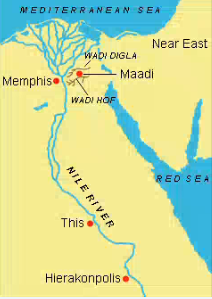

 The city of Memphis, located on the Nile near the modern city of Cairo, was founded around 3100 B.C. as the first capital of a recently united Egypt. The choice of Memphis by Egypt's first kings reflects the site's strategic importance. First, and most obvious, the apex of the Nile River delta was a politically opportune location for the state's administrative center, standing between the united lands of Upper and Lower Egypt and offering ready access to both parts of the country. The older predynastic (pre-3100 B.C.) centers of power, This and Hierakonpolis, were too remote from the vast expanse of the delta, which had been incorporated into the unified state. Only a city within easy reach of both the Nile valley to the south and the more spread out, difficult terrain to the north could provide the necessary political control that the rulers of early dynastic Egypt (roughly 3000-2600 B.C.) required.
The city of Memphis, located on the Nile near the modern city of Cairo, was founded around 3100 B.C. as the first capital of a recently united Egypt. The choice of Memphis by Egypt's first kings reflects the site's strategic importance. First, and most obvious, the apex of the Nile River delta was a politically opportune location for the state's administrative center, standing between the united lands of Upper and Lower Egypt and offering ready access to both parts of the country. The older predynastic (pre-3100 B.C.) centers of power, This and Hierakonpolis, were too remote from the vast expanse of the delta, which had been incorporated into the unified state. Only a city within easy reach of both the Nile valley to the south and the more spread out, difficult terrain to the north could provide the necessary political control that the rulers of early dynastic Egypt (roughly 3000-2600 B.C.) required.

名师1对1,深度分析薄弱项,高效提分